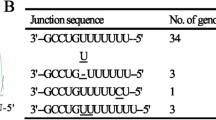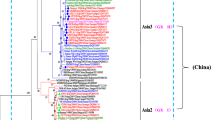Abstract
In this study, a street rabies virus isolate, GXHXN, was obtained from the brain of one rabid cattle in Guangxi province of southern China. To characterize the biological properties of GXHXN, we first evaluated its pathogenicity using 4-week-old adult mice. GXHXN was highly pathogenic with a short incubation period and course of disease. Its LD50 of 10−6.86/mL is significantly higher than the LD50 of 10−5.19/mL of GXN119, a dog-derived rabies virus isolate. It also displayed a higher neurotropism index than the rRC-HL strain. However, the relative neurotropism index of GXHXN was slightly lower than that of GXN119. Analyzing antigenicity using anti-N and anti-G monoclonal antibodies (MAbs), all tested anti-N MAbs reacted similarly to GXHXN, CVS, and rRC-HL, but the reaction of anti-N MAbs to GXHXN was slightly different from GXN119. Moreover, 2/11 tested anti-G mAbs showed weaker reactivity to GXHXN than rRC-HL, whereas 4/11 showed stronger reactivity to GXHXN than CVS and GXN119, indicating that the structures of G might differ. In order to understand its genetic variation and evolution, the complete GXHXN genome sequence was determined and compared with the known 12 isolates from other mammals. A total of 42 nucleotide substitutions were found in the full-length genome, including 15 non-synonymous mutations. The G gene accounts for the highest nucleotide substitution rate of 0.70 % in ORF and an amino acid substitution rate of 0.95 %. Phylogenetic trees based on the complete genome sequence as well as the N and G gene sequences from 37 known rabies isolates from various mammals demonstrated that the GXHXN is closely related to the BJ2011E isolate from a horse in Beijing, the WH11 isolate from a donkey in Hubei, and isolates from dogs in the Fujian and Zhejiang provinces. These findings will be helpful in exploring the molecular mechanisms underlying interspecies transmission and the genetic variation of the rabies virus in different mammal species.



Similar content being viewed by others
References
World Health Organization, WHO Expert Committee on Rabies. 2004. World Health Organization, Geneva, Switzerland (2005)
K.K. Conzelmann, J.H. Cox, L.G. Schneider, H.J. Thiel, Virology 175(2), 485–499 (1990)
C.E. Rupprecht, C.A. Hanlon, T. Hemachudha, Lancet Infect Dis 2, 327–343 (2002)
J.S. Smith, Clin. Microbiol. Rev. 9, 166–176 (1996)
Y. Jiang, X. Yu, L. Wang, Z. Lu, H. Liu, H. Xuan, Z. Hu, C. Tu, Epidemiol. Infect. 136, 504–508 (2008)
P. Ming, J. Yan, S. Rayner, S. Meng, G. Xu, Q. Tang, J. Wu, J. Luo, X. Yang, J. Gen. Virol. 91, 759–764 (2010)
T. Xie, H. Yu, J. Wu, P. Ming, S. Huang, Z. Shen, G. Xu, J. Yan, B. Yu, D. Zhou, Virus Genes 45(3), 452–462 (2012)
K.S. Zhang, J.H. Guo, Z.F. Xu, M. Xiang, B. Wu, H.C. Chen, Virol J. 8, 101 (2011)
S. Zhang, J. Zhao, Y. Liu, A.R. Fooks, F. Zhang, R. Hu, Virus Res. 149, 143–151 (2010)
Y.Z. Zhang, C.L. Xiong, Y. Zou, D.M. Wang, R.J. Jiang, Q.Y. Xiao, Z.Y. Hao, L.Z. Zhang, Y.X. Yu, Z.F. Fu, Virus Res. 121, 179–188 (2006)
M. Song, Q. Tang, D.M. Wang, Z.J. Mo, S.H. Guo, H. Li, X.Y. Tao, C.E. Rupprecht, Z.J. Feng, G.D. Liang, BMC Infect. Dis. 9, 210 (2009)
X.Y. Tao, Q. Tang, H. Li, Z.J. Mo, H. Zhang, D.M. Wang, Q. Zhang, M. Song, A. Velasco-Villa, X. Wu, C.E. Rupprecht, G.D. Liang, Emerg. Infect. Dis. 15, 1192–1198 (2009)
Q. Liu, Y. Xiong, T.R. Luo, Y.C. Wei, S.J. Nan, F. Liu, Y. Pan, L. Feng, W. Zhu, K. Liu, J.G. Guo, H.M. Li, J. Clin. Virol. 39(4), 295–303 (2007)
N. Ito, M. Takayama, K. Yamada, M. Sugiyama, N. Minamoto, J. Virol. 5, 9121–9128 (2001)
T.R. Luo, N. Minamoto, M. Hishida, K. Yamamoto, T. Fujise, S. Hiraga, N. Ito, M. Sugiyama, T. Kinjo, Microbiol. Immunol. 42(3), 187–193 (1998)
L.J. Reed, H. Muench, Am. J. Epidemiol. 27, 493–497 (1938)
L. Geue, S. Schares, C. Schnick, J. Kliemt, A. Beckert, C. Freuling, F.J. Conraths, B. Hoffmann, R. Zanoni, D. Marston, L. McElhinney, N. Johnson, A.R. Fooks, N. Tordo, T. Müller, Vaccine 26, 3227–3235 (2008)
K. Tamura, D. Peterson, N. Peterson, G. Stecher, M. Nei, S. Kumar, Mol. Biol. Evol. 28, 2731–2739 (2011)
K. Morimoto, D.C. Hooper, H. Carbaugh, Z.F. Fu, H. Koprowski, B. Dietzschold, PNAS 95, 3152–3156 (1998)
N. Minamoto, H. Tanaka, M. Hishida, H. Goto, H. Ito, K. Yamamoto, M. Sugiyama, T. Kinjo, K. Mannen, K. Mifune, Microbiol. Immunol. 38(6), 449–455 (1994)
C. Tuffereau, H. Leblois, J. Bénéjean, P. Coulon, F. Lafay, A. Flamand, Virology 172, 206–212 (1989)
M. Takayama-Ito, N. Ito, K. Yamada, M. Sugiyama, N. Minamoto, Virus Res. 115, 169–175 (2006)
T.L. Lentz, T.G. Burrage, A.L. Smith, J. Crick, G.H. Tignor, Science 215, 182–184 (1982)
T.L. Lentz, R.J. Benson, D. Klimowicz, P.T. Wilson, E. Hawrot, Brain Res. 387, 211–219 (1986)
L. Bracci, G. Antoni, M.G. Cusi, L. Lozzi, N. Niccolai, S. Petreni, M. Rustici, A. Santucci, P. Soldani, P.E. Valensin, P. Neri, Mol. Immunol. 25, 881–888 (1988)
X. Tang, M. Luo, S. Zhang, A.R. Fooks, R. Hu, C. Tu, Emerg. Infect. Dis. 11(12), 1970–1972 (2005)
Acknowledgments
We thank Prof Minamoto (Gifu University, Japan) for providing anti-N/G MAbs of rabies, the local veterinary stations for their valuable support in collecting samples, and Dr. Bernard Goodman for kindly editing the main text. The study is supported by the Fund Program of the Director of the Key Laboratory of Ministry of Education for Microbial and Plant Genetic Engineering, Guangxi University, and by the Plans for Creative Training of Post-Graduates in Guangxi University (2010.12–2011.12), and Innovation Project of Guangxi Graduate Education (20110245) to Hai-Bo Tang
Conflict of interest
We declare that we have no conflict of interest.
Author information
Authors and Affiliations
Corresponding author
Rights and permissions
About this article
Cite this article
Tang, HB., Lu, ZL., Zhong, YZ. et al. Characterization of the biological properties and complete genome sequence analysis of a cattle-derived rabies virus isolate from the Guangxi province of southern China. Virus Genes 49, 417–427 (2014). https://doi.org/10.1007/s11262-014-1108-2
Received:
Accepted:
Published:
Issue Date:
DOI: https://doi.org/10.1007/s11262-014-1108-2




